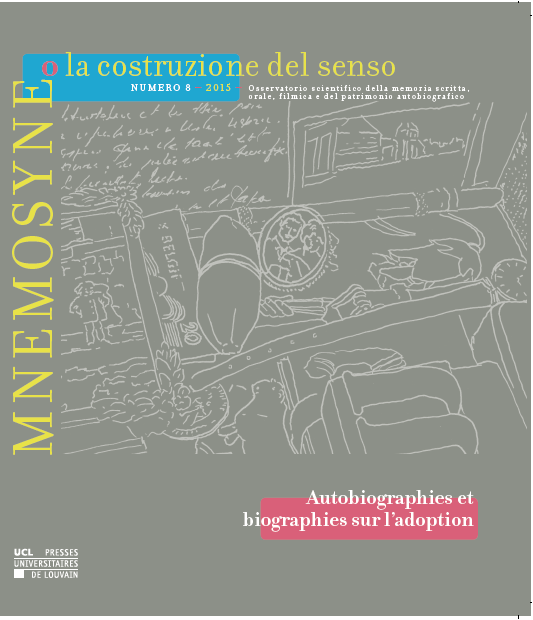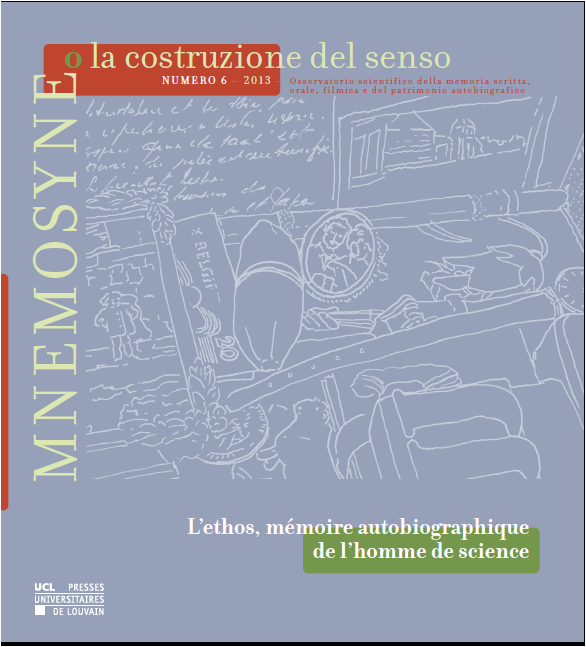Publications
Salon de la revue Paris 13-15 Octobre
Mnemosyne o la costruzione in Open access
DOWNLOAD BOOK OF ABSTRACTS HERE
DOWNLOAD THE PROGRAM 2016 HERE
MEDIAPOLIS.EUROPA in cooperation with the Biblioteca di storia moderna e contemporanea (Library for modern and contemporary history) and the Istituto centrale per i beni sonori e audiovisivi (Central institute for the auditory and audiovisual patrimony)
|
XV Symposium of the scientific Observatory of the written, oral and filmic memory and of the autobiographical patrimony 20 - 22 June 2016, Palazzo Mattei, Rome, Italy |
Auto/biography: its telescopic and temporal dimensions
Which linguistic modalities, which spacial and temporal perspectives give meaning to the past within the autobiographical narrations? How do famous or common people structure in their autobiographies the relation between the time of the narration and the time of the event? How is that memory brought back?
The general trend is to assume a well-planned strategy into the structured writings of authors who express themselves using a determined code and a well-established style (see for instance the Mémoires d’outre-tombe by R.-F. Chateaubriand; or Into the Confessions by J.-J Rousseau), while tailored instruments are needed to analyse the autobiographical expressions written by common people or by people whose main purpose is to communicate rather than to pursue a rhetoric style, paying more attention to the what than to the how (cfr: A. Piromalli-D. Scarfoglio, Pier Paolo Pasolini, volgar’ eloquio, Napoli, Athena, 1976, p. 60). When we look into the autobiographical memories of scientists we notice for example, that the outcome of the research correlates strongly with all previous paths. And in the history of visual arts, the past has frequently been dressed up with present appearances.
Without entering into the details of the extensive bibliography on this topic - ranging from the literary criticism fundamental studies by M. Bakhtin, G. Genette, Ph. Hamon, Ph. Lejeune, W. Pater, C. Segre, J. Starobinski, to the linguistics ones by É. Benveniste a M. Grévisse, G. Lakoff, W. J. Ong, H. Weinrich, to the historical and literary essays by Gramsci and Benjamin, to the more specific sectorial studies -, the key question is how the narrating subject makes his/her self-narration truthful, which modalities and which rhetorical tools are exploited in the here and now. Many ideas for such an analysis may come from the reading of Le miroir d’Hérodote, Essai sur la représentation de l’autre by François Hartog who analyses how Herodotus positions himself as an historian, by means of which rethorical strategies, and how he puts into effect his own present through the historiê, the inquiry. When he communicates his historiê Herodotus resorts to the first person: "As for me I do not claim to decide how the facts had happened", The Histories I, 5. Is the ‘I’ into his own present fortifying or weakening the evidences of his narration? Herodotus communicates as well precisely the nature of the sources he uses: "I was unable to learn anything from anyone else, but this much further I did learn by the most extensive investigation that I could make, going as far as the city of Elephantine to look myself, and beyond that by question and hearsay", II, 29. He narrates about legends as if true, because they were absorbed as such into the popular culture. Analysing the contemporary theatre of narration by authors like Celestini, Paolini, Perrotta, one realizes that ancient techniques of historical narration are present and they are very close to the ones employed by Herodotus: history interpreted as an amalgam of certified facts, but also history as a result of beliefs, of the mythical interpretation of reality that became part of the ordinary. A choice rejected by Thucydides who emphasises the importance of the written evidence.
Hartog asserts that after using the third person Herodotus comes back to the first person conveying the familiar landmark of the hic et nunc of the utterance (F. Hartog, Le Miroir d’Hérodote, p. 32). Hartog quotes Grévisse who refers to a gnomic present, a present dictating verdicts, often strengthened by the use of pronouns, adverbs and also transition words, like here, there, in such a way, ecc. In the book on the utterance of time he confers the use of the present to the purpose of commenting and not of narrating (Hartog’s presentism). Furthermore recalling the sight and the hearing means reporting directly and reliably what has been experienced. Aristotle in his Metaphysics maintains that through the sight one increases his/her knowledge and can perceive differences.
In many autobiographical works one could start from the last chapter to unravel the logic, to rebuild the narration when the first person is used, to follow the perspective of Furthermore the idea of ethos referred to the ars oratoria plays a role, in line with Aristotle 's thoughts, but here more specifically to the structuring of an identity.
It is obvious that history is always subject to interpretation (Gramsci, Benjamin). Nevertheless many questions remain open on how this perspective materialises and which meanings it carries in the different contexts: this concerns especially the statements of people who do not assume the role of authors.
Some specific suggestions:
1) Comparing diary and autobiography
Opposing concepts may arise when one narrates oneself in the present or after some time has passed. In the scientific world Rita Levi Montalcini is an outstanding example of this. She has been writing all along her career letters in which she narrates day by day the joy for the progress made in her research, the expectations, the circumstances of the scientific findings, with a narration permeated by confidence in the future, a permanent positive feeling of hope and an open attitude accepting the hazardous side of science and the playful side of life. A permanent optimism transpires from her letters. On the contrary in her autobiographical works a non-pioneering view is evident, almost pessimistic, and reveals to the reader her philosophy of life. A very strong code of ethics dominates her autobiography. Several other scientific autobiographies are also very explanatory as for the narrators the present now determines the scanning of the past. In particular, see the recent autobiographical work by Svante Pääbo about his pioneering description of Neanderthal man's genoma. The whole of his past life and his research take a precise shape and goal, and they all become coherent and clear in the present of his narration (S. Pääbo, Neanderthal Man. In Search of Lost Genomes, 2014).
2) The oral communication
The expressions, the sayings, the pauses, the tenses of the verbs, the expansion or restriction of specific events, are evidence of his autobiographical narration. The presence of another person has for sure an influence. Interviews, confessions etc. highlight specific manners of communication and transmission. The other person may facilitate or prevent the integrity of the transmission. While constructing one’s subjectivity through the narration and thus through the memory, the use of the first person and of the present verb are extremely meaningful; the choice may be linguistically conscious or unconscious but it points at a specific relation between the time of the circumstances and the time of the narration, between the I who narrates and the I who lived the circumstances (Cfr: É. Benveniste, «Les relations de temps dans le verbe français», in Id. Problèmes de linguistique générale, I, Paris, Gallimard, 1974; H. Weinrich, Tempus. Besprochene und erzählte Welt, 1964).
Audiovisual interviews reporting one’s life story are meaningful: see among others, and again about scientists autobiographies, the documentary Fermat’s Last Theorem by Simon Singh and John Lynch, where Andrew Wiles narrates his struggle to demonstrate a Theorem unsolved for four centuries. Wiles’ narration in the present enlightens and articulates all his past.
Foucault has pointed out a peculiarity of oral communication. In his Le courage de la vérité he underlines how the dialectical process going on with the interlocutor and the overcoming of the inconsistencies are clear signs of courage as they reveal an ongoing soul searching. In ancient times telling the truth about oneself was of great importance. The simultaneity of narrating and being listened to was also a peculiarity of ancient times ethics. Foucault has always reflected on the notion of time and the different techniques used to pursue a specific, intentional and chosen identity. As a matter of fact he does believe that the subject is the outcome of an actual work of construction: one could mention his text L’Herméneutique du sujet, Cours au Collège de France, 1981-1982, Hautes Études, Paris, Gallimard-Seuil, 2001.
All reflections about the main topics resumed above will be welcome.
|
ABSTRACT SUBMISSION |
A) The deadline to submit the proposal is: 15 January 2016. You are kindly asked to respect the following standard while submitting your proposal. The abstract has to be submitted online at http://mediapoliseuropa.com/ with a CV (abstracts should contain maximum 250 words, 100 for the short CV) and mention at least two references and possibly two papers or publication by the author.
In case you would like to propose a specific session (which shall include at least 3 to 4 interventions) you may send by the 1st of December 2015 the subject topic you propose to be discussed following strictly the same standard mentioned above for the proposals. The scientific committee will examine and select all proposal submitted to the specific conference registration area of our website http://mediapoliseuropa.com/
LANGUAGES ADMITTED FOR THE INTERVENTIONS: French, English, Italian, Spanish
For any information you may need do not hesitate to contact:
This email address is being protected from spambots. You need JavaScript enabled to view it. , This email address is being protected from spambots. You need JavaScript enabled to view it. ,
B) By the 10 of February 2016 you will be notified about the acceptance of your proposal.
|
REGISTRATION FEES |
http://mediapoliseuropa.com/index.php/conference-registration-it
The cultural association Mediapolis.Europa contributes to the annual publication of the journal Mnemosyne, o la costruzione del senso, Presses universitaires de Louvain, which has published many interventions of the past years Symposiums.
Scientific Committee
Beatrice Barbalato, Mediapolis.Europa, e Université catholique de Louvain
Fabio Cismondi, Euro Fusion
Irene Meliciani, Mediapolis Europa
Albert Mingelgrün, Université Libre de Bruxelles
Giulia Pelillo-Hestermeyer, Universität Heidelberg
Edgar Radtke, Universität Heidelberg
Francesca Socrate, Sapienza, Università di Roma
Anna Tylusińska-Kowalska, Uniwersytet Warszawski
Organization
Irene Meliciani, managing director Mediapolis.Europa


Partners
PAST EVENTS
- Mediapolis.Europa is happy to announce that mnemosyne o la costruzione del senso is now part of ERIH
- Mediapolis.Europa in radio fahrenheit
- Prof Beatrice Barbalato à France Culture La conversation scientifique
PAST EVENTS
- Mediapolis.Europa is happy to announce that mnemosyne o la costruzione del senso is now part of ERIH
- Mediapolis.Europa in radio fahrenheit
- Prof Beatrice Barbalato à France Culture La conversation scientifique








